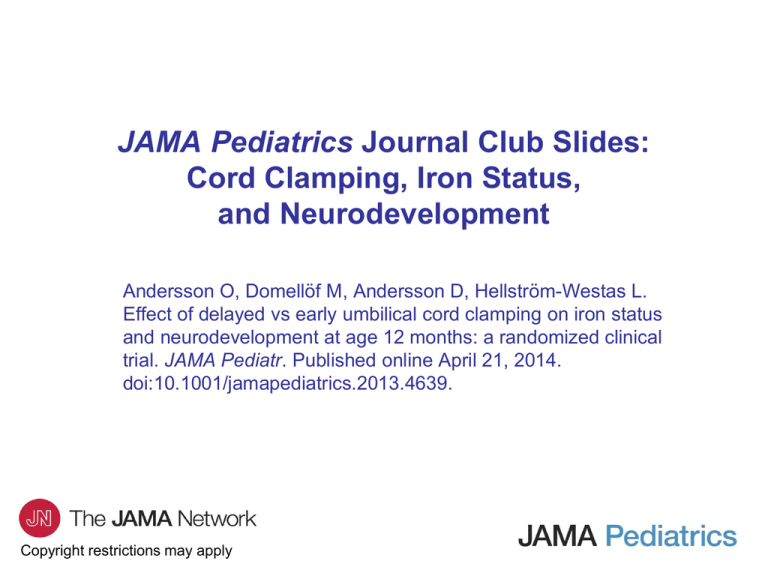
JAMA Pediatrics Journal Club Slides:
Cord Clamping, Iron Status,
and Neurodevelopment
Andersson O, Domellöf M, Andersson D, Hellström-Westas L.
Effect of delayed vs early umbilical cord clamping on iron status
and neurodevelopment at age 12 months: a randomized clinical
trial. JAMA Pediatr. Published online April 21, 2014.
doi:10.1001/jamapediatrics.2013.4639.
Copyright restrictions may apply
Introduction
•
Background
– Prevention of iron deficiency in infancy may promote neurodevelopment.
Delayed cord clamping (DCC) can prevent iron deficiency during the first
6 months of life. However, no data are available on long-term effects on
infant outcomes in relation to time for umbilical cord clamping.
•
Study Objective
– To investigate effects of DCC, as compared with early cord clamping
(ECC), on infant iron status and neurodevelopment at age 12 months in a
European setting.
Copyright restrictions may apply
Methods
•
Study Design
– Randomized clinical trial.
•
Setting
– Swedish county hospital.
•
Participants
– 382 Full-term infants born after a low-risk pregnancy.
Copyright restrictions may apply
Methods
•
Outcomes
– The main outcome was iron status at age 12 months (ferritin level,
transferrin saturation, soluble transferrin receptor level, reticulocyte
hemoglobin level, and mean cell volume).
– The secondary outcome was parental assessment of neurodevelopment
by the Ages and Stages Questionnaire, second edition (ASQ).
•
Limitations
– Sample size
• The study was calculated to demonstrate a difference in ferritin levels
at age 4 months. As no earlier studies on cord clamping had studied
iron status and neurodevelopment at age 12 months, calculations on
sample size for these outcomes could not be performed before
commencement of the study.
– Bias
• Parents (who reported development by answering the ASQ) were
blinded for the intervention.
Copyright restrictions may apply
Results
•
In total, 347 of 382 infants (90.8%) were assessed.
•
The DCC and ECC groups did not differ in iron status or
neurodevelopment at age 12 months.
•
Predictors of ferritin levels were infant sex and ferritin in umbilical cord
blood. Predictors of ASQ score were infant sex and breastfeeding within
1 hour after birth.
•
For both outcomes, being a boy was associated with lower results.
Interaction analysis showed that DCC was associated with an ASQ
score 5 points higher among boys but 12 points lower among girls, out
of a maximum of 300 points.
Copyright restrictions may apply
Results
Iron Status at Age 12 Months in Infants Randomized
to Delayed or Early Umbilical Cord Clampinga
Copyright restrictions may apply
Results
Neurodevelopment at Age 12 Months, as Assessed by the ASQ, in TermBorn Infants Randomized to Delayed or Early Umbilical Cord Clampinga
Copyright restrictions may apply
Comment
•
Iron stores at age 12 months
– In this study, iron stores were assessed by different indicators of iron
status: hemoglobin level, mean cell volume, reticulocyte hemoglobin
level, ferritin level, transferrin saturation, and soluble transferrin receptor
level. Even when comparing the levels of each one of these indicators,
we could not demonstrate any differences in iron status between the
DCC and ECC groups.
– We found that ferritin in umbilical cord blood was a strong predictor of
ferritin at 12 months.
Copyright restrictions may apply
Comment
•
Neurodevelopment at age 12 months
– We hypothesized that the improved iron status at age 4 months would
promote infant neurodevelopment at age 12 months.
– In the study, neither the total ASQ score nor the subscores of the
different domains differed between the groups. Furthermore, we did not
find any associations between iron status at birth or age 4 months and
total ASQ score at age 12 months.
– Interaction analysis showed that the effect of the intervention differed
according to infant sex, as DCC seemed to lower the ASQ score in girls
and increase the score in boys, a finding that prompts a more detailed
follow-up of these children.
Copyright restrictions may apply
Comment
•
In summary, although DCC improved hematological status in the newborn
period and iron status at age 4 months, it did not affect iron status or
neurodevelopment assessed by the ASQ at age 12 months.
•
Future research in this area should be directed at studying development at
later ages and at assessing long-term effects of DCC on iron status and
development in communities with higher rates of iron deficiency and
anemia.
•
The possible reverse effect on girls’ and boys’ development might also be
taken into account.
Copyright restrictions may apply
Contact Information
•
If you have questions, please contact the corresponding author:
– Ola Andersson, MD, PhD, Department of Women’s and
Children’s Health, Uppsala University, SE-751 85 Uppsala,
Sweden (ola.andersson@kbh.uu.se).
Funding/Support
•
This work was supported by grants from the Regional Scientific
Council of Halland, common funds for development and research
from the Southern Healthcare Region, H.R.H. Crown Princess
Lovisa’s Society for Child Care, Uppsala University, and The
Framework of Positive Scientific Culture, Hospital of Halland.
Conflict of Interest Disclosures
•
None reported.
Copyright restrictions may apply










